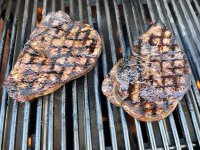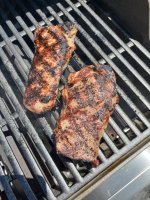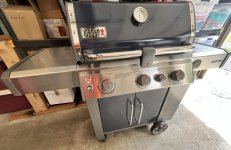Forgive me if this issue/concern has been previously discussed and, perhaps, beaten to death, it has been a while since I was last here.
My concern is the changes made to the Genesis and, quite frankly, ALL Weber gas grills. Additionally, I am disturbed by changes to the corporate structure of the company. The company WAS privately held, then taken public, issuing stock and traded on one of the exchanges. It has since been taken private again, by a private equity company, as I understand it. If I am mistaken about this most recent move, forgive me and feel free to set me straight.
All these changes have resulted in some, what I believe to be, drastic changes to the product and the operation of this company.
At one time, we could get real, true, useful assistance from the customer service staff who operated the phones. Now, staff are, at least seemingly, somewhere in Asia and have little-to-no real-life understanding of the changes made to the grills, nor how they operate, beyond a basic click the igniter; heat the grill; put what’s to be grilled on the grates; and cook it to desired “doneness”.
Disappointed with this, I called the corporate offices in Illinois and left a message on some line. I was surprised and grateful to receive a callback the next day. That was the only thing that was “ pleasing” about that experience.
I made clear what I was hoping to achieve with my conversation and achieved absolutely nothing that I had hope for.
I made it clear that I had questions about why the orientation of the burners was changed from their former direction of side-to-side to their current front-to-back orientation. I wanted to know how the decision was arrived at, what the supposed advantages and benefits were. What drove this decision?It seems to me that this was a pretty major change and one that would not have been made without some thoughtful reasoning and, possibly, some discussion among, MAYBE, an engineer, or two.
My correspondent had no clue. He only knew that the burners, yes, ARE oriented in this direction. WHY? NO CLUE. I offered up my opinion on why this could be problematic when trying to rotisserie, say, a chicken. The burners, in the former orientation, were perfect for indirect heating, with the front and rear burners applying the heat, were directing their heat to the bulkiest part of the bird - its breasts, making for a damn good finished product, imho (and that, the opinion that is, of those whom I served the bird). I, stupidly continued this line of inquiry - again, why this was done? Still absolutely NO IDEA.
OKAY. On to, maybe something he might know (fingers crossed). Now this change may have been done years before this kid had begun working for the company. For a little background, my current Silver Genesis was made in 2001 and purchased in May of 2002. It is a natural gas model that still works like a champ. Over the years, I have casually looked at the models at HD and Lowes, without really looking too deeply at them, because mine works so weil. My only cause for considering a change is that, while the cookbox and burners are in EXCELLENT condition, the frame of its support structure is rusting out, in spite my good for it. I have looked for a new structure with no luck. I am willing to do a rebuild in order to preserve the grill, but it’s been difficult to find the frame.
I asked about the change from cast aluminum cookboxes to the current stainless steel. Again, crickets. This guy seemed to not even know that the cookbox was, virtually forever, constructed in that manner and that a change HAD occurred.
There are many other things, things that I believe we are all aware of, things that stem from smaller decisions to “cheapen” the product, from their being made overseas, to the simple inferior quality components now being used. Guess it’s simply a sign of the times and an old fart like me who remembers the “good old days” is aging out of the market. Those consumers now coming in to that market have no idea of what “ was” and now simply accepts what “is” because there’s nothing to which they can compare it
I am at the point at which I’m about to give in and give up and go to another manufacturer. It seems that the others also orient their burners in the same manner, and I am totally reluctant to move from the brand I have trusted for over 40 years, owning concurrently, both gas models and charcoal kettles and replacing various parts when they have outlived their usefulness.
The ONLY things I have had to replace on either models (save for two of the four kettles I have owned that just plum wore out; one of the kettle grills, my first, was replaced when I “graduated” from the 18” to the 22.5” model. I gifted the smaller one to my brother, who continued using it for about another 12 years.) were “flavorizer” bars and the grates). I received my first gas-burning Weber Genesis in 1987 as a gift from my father-in-law and replaced it in 2002.
I have “coached” others on THEIR purchase decisions over the years, always singing the praise of Webers, but I am quite sadly “done”, I am disappointed to say.
I simply cannot buy from someone who has abandoned its principles AND its loyal followers.
Anyone out there’s disappointed as I?
(Sorry for the length of this, but I figure we’re all pretty passionate about these grills, otherwise, we wouldn’t be here.)
My concern is the changes made to the Genesis and, quite frankly, ALL Weber gas grills. Additionally, I am disturbed by changes to the corporate structure of the company. The company WAS privately held, then taken public, issuing stock and traded on one of the exchanges. It has since been taken private again, by a private equity company, as I understand it. If I am mistaken about this most recent move, forgive me and feel free to set me straight.
All these changes have resulted in some, what I believe to be, drastic changes to the product and the operation of this company.
At one time, we could get real, true, useful assistance from the customer service staff who operated the phones. Now, staff are, at least seemingly, somewhere in Asia and have little-to-no real-life understanding of the changes made to the grills, nor how they operate, beyond a basic click the igniter; heat the grill; put what’s to be grilled on the grates; and cook it to desired “doneness”.
Disappointed with this, I called the corporate offices in Illinois and left a message on some line. I was surprised and grateful to receive a callback the next day. That was the only thing that was “ pleasing” about that experience.
I made clear what I was hoping to achieve with my conversation and achieved absolutely nothing that I had hope for.
I made it clear that I had questions about why the orientation of the burners was changed from their former direction of side-to-side to their current front-to-back orientation. I wanted to know how the decision was arrived at, what the supposed advantages and benefits were. What drove this decision?It seems to me that this was a pretty major change and one that would not have been made without some thoughtful reasoning and, possibly, some discussion among, MAYBE, an engineer, or two.
My correspondent had no clue. He only knew that the burners, yes, ARE oriented in this direction. WHY? NO CLUE. I offered up my opinion on why this could be problematic when trying to rotisserie, say, a chicken. The burners, in the former orientation, were perfect for indirect heating, with the front and rear burners applying the heat, were directing their heat to the bulkiest part of the bird - its breasts, making for a damn good finished product, imho (and that, the opinion that is, of those whom I served the bird). I, stupidly continued this line of inquiry - again, why this was done? Still absolutely NO IDEA.
OKAY. On to, maybe something he might know (fingers crossed). Now this change may have been done years before this kid had begun working for the company. For a little background, my current Silver Genesis was made in 2001 and purchased in May of 2002. It is a natural gas model that still works like a champ. Over the years, I have casually looked at the models at HD and Lowes, without really looking too deeply at them, because mine works so weil. My only cause for considering a change is that, while the cookbox and burners are in EXCELLENT condition, the frame of its support structure is rusting out, in spite my good for it. I have looked for a new structure with no luck. I am willing to do a rebuild in order to preserve the grill, but it’s been difficult to find the frame.
I asked about the change from cast aluminum cookboxes to the current stainless steel. Again, crickets. This guy seemed to not even know that the cookbox was, virtually forever, constructed in that manner and that a change HAD occurred.
There are many other things, things that I believe we are all aware of, things that stem from smaller decisions to “cheapen” the product, from their being made overseas, to the simple inferior quality components now being used. Guess it’s simply a sign of the times and an old fart like me who remembers the “good old days” is aging out of the market. Those consumers now coming in to that market have no idea of what “ was” and now simply accepts what “is” because there’s nothing to which they can compare it
I am at the point at which I’m about to give in and give up and go to another manufacturer. It seems that the others also orient their burners in the same manner, and I am totally reluctant to move from the brand I have trusted for over 40 years, owning concurrently, both gas models and charcoal kettles and replacing various parts when they have outlived their usefulness.
The ONLY things I have had to replace on either models (save for two of the four kettles I have owned that just plum wore out; one of the kettle grills, my first, was replaced when I “graduated” from the 18” to the 22.5” model. I gifted the smaller one to my brother, who continued using it for about another 12 years.) were “flavorizer” bars and the grates). I received my first gas-burning Weber Genesis in 1987 as a gift from my father-in-law and replaced it in 2002.
I have “coached” others on THEIR purchase decisions over the years, always singing the praise of Webers, but I am quite sadly “done”, I am disappointed to say.
I simply cannot buy from someone who has abandoned its principles AND its loyal followers.
Anyone out there’s disappointed as I?
(Sorry for the length of this, but I figure we’re all pretty passionate about these grills, otherwise, we wouldn’t be here.)




